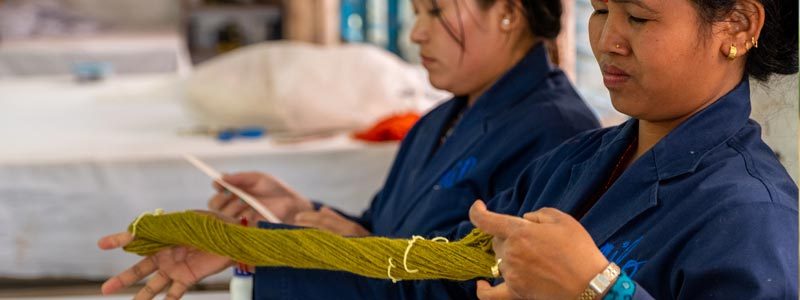Il commercio equo-solidale è importante nel ridurre la povertà
- Autore dell'articolo:admin
- Articolo pubblicato:Marzo 31, 2020
- Categoria dell'articolo:Lana di lusso

A Minimum Wage Is Controversial With A Decent Life
In the textile industry, it seems that not much has changed in 20 years. Due to the continued pressure of competition in a globalized economy, clothing manufacturers searching for low paid labour has intensified. In developing countries, most women are working in the manufacturing sectors. These women have few other paid employment alternatives.
In 2012, the World Bank started a program in Bangladesh called NARI, to train women from extremely poor areas to become semi-skilled workers in the textile industry. These women had to leave their family but were offered the training to become a textile worker. During the training, housing and food were provided. As a result, their living conditions were on a higher level and different from what these young women were used to in their local villages. The objective was to provide work for women in factories inside 3 exports zones having better conditions and safeguards for workers. Until today we do not know if the goal was reached. We do not know if these women were able to increase their living standards compared to the time they were living in their village. By living in a big city, paying a second rent for an apartment in an urban area and having a salary based on a minimum wage, the minimum salary authorized by a government, while trying to save money to send back to the family it is unclear whether these women are really living a decent life.
In the documentary “Sweatshop-Deadly Fashion” the television channel APTV.NO, we can follow the experience of three Norwegian fashion bloggers, who are going to live the life of a Cambodian textile factory worker for a week. Within no time, the bloggers realize that it is almost impossible to have a decent life on the wages they earn. Apparently, wages for textile workers are higher than low skilled agriculture workers but due to huge pressure from brands on prices, the salary is in most cases still based on a minimum wage and not a living wage, which makes a big difference.
Therefore a living wage, which means a salary that is high enough to maintain a normal standard of living, should be considered as the lowest wage to live a decent life. These people, contrary to people working in agriculture, are often working far away from home, living in very poor conditions in urban areas, working day in and day out, 10 or more hours. They do not see their family on a regular basis and are working with the only objective to give their children a better future.
Today the trend in the apparel industry is “fast fashion” where low prices are key. Which obliges the factory owner to continue to pay his employees on a minimum wage basis. Luckily this is different for factories that are following the Fair Trade principles where people get a higher salary and can receive some of the sales profit. Brands working with factories in urban areas should follow the example of outdoor brand Patagonia; they are increasing the number of factories working following the fair trade standards. By producing in this way it closes the gap on the lack of transparency and visibility. Giving people back their dignity by receiving a fair payment for the work done.

Social Businesses Help People Avoid Moving To Big Cities
Another solution to reduce poverty in the textile industry can be to follow the example of Yunus Muhammad, creating social business plans, considering and covering the whole picture, increasing responsibility and respecting a fair payment for people in remote areas. Helping them to stay close to their family. For example, the outdoor brand Sherpa works with women in mountain areas in Nepal for the handknitting of their beanies and pullovers. Women do not need to leave their families behind and move to Kathmandu.
In Mongolia, a program was developed helping women of herders increasing their income. They received a handspun training and material to produce handspun yarns during the winter time. A similar program was developed in Nepal, where women after they finished their daily housework, are gathering together to produce handspun yarns for the international but also the local market.
Because of these positive projects, people are able to stay in their environment close to their families and develop social business or a cooperative.
A textile brand should consider the whole picture during their supply chain while collaborating to decrease poverty. Developing and integrating not only short-term factors but also considering the future living standards of the workers.
Written by Coty Jeronimus. This article was first published 07 November 2017 on Tasklab.
